No aircraft, no escorts, no kettles. How much truth can be found in the many myths surrounding HMS Queen Elizabeth and her sister HMS Prince of Wales?
There are scores of myths, rumours and outright nonsense circulating on the internet and even in newspapers about the new Queen Elizabeth class aircraft carriers.
We spend a lot of time pointing out these myths, writing articles about them and directing people to the different articles in an attempt to set the record straight. One of our readers recently asked, ‘Why not just write one article covering the myths?’, so we have.

There’s simply not enough time to discuss or counter everyone of the myths about these vessels so let’s take a look at the most common and resilient myths surrounding HMS Queen Elizabeth and her sister HMS Prince of Wales.

If there’s anything we’ve missed, please let us know!
1. ‘The carriers don’t have any aircraft’
This one even gets repeated by politicians, many of you will be aware of our Twitter campaign to correct this claim across the political spectrum.

Claims the carrier do not have any aircraft are simply incorrect, the UK as of now has 18 F-35B jets with more to be delivered over the coming years in addition to numerous of helicopters of various types.
Today we mark the historic first #F35 landing on the deck of HMS Queen Elizabeth as a monumental first for the Royal Navy and the Royal Air Force. #F35OnDeck pic.twitter.com/LmtluLUJsP
— Ministry of Defence 🇬🇧 (@DefenceHQ) September 28, 2018
The first jets touched down in 2018.
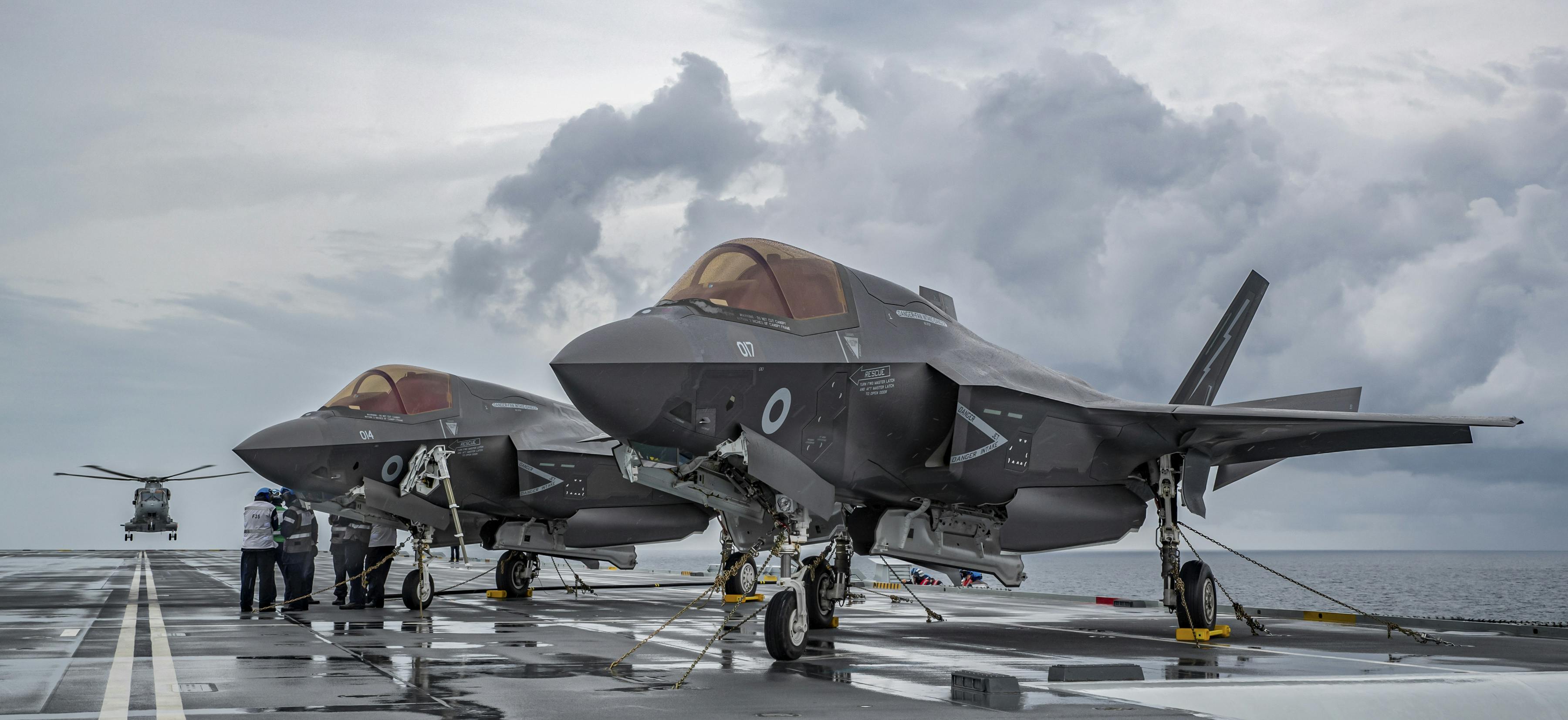
In 2023, the UK will have 42 F-35 aircraft, with 24 being front-line fighters and the remaining 18 will be used for training (at least 5 on the OCU), be in reserve or in maintenance.

2. ‘The computer systems run on Windows XP’.
Confusion on this often brought up myth seems to come from the fact former Defence Secretary Michael Fallon didn’t deny the suggestion the vessels used Windows XP after an image of a laptop appearing to use the operating system (OS) surfaced, the only trouble with this is he doesn’t actually seem to know any better. The Queen Elizabeth class run on the Shared Infrastructure operating system.
Simply put, the system is used in the same way Windows RE is used on commercial machines today, as a recovery and maintenance environment. The use of one operating system in the maintenance of another is not uncommon. XP doesn’t run any systems on-board either carrier.
It should be noted that none of these systems that use XP in this manner are vulnerable to outside attack in the same way the NHS and other organisations were hit. Speculation was rife on this very topic two years ago an image of Windows XP was seen on a technicians laptop during a documentary.
The MoD said:
“The MoD can confirm that Windows XP will not be used by any onboard system when the ship becomes operational, this also applies to HMS Prince of Wales.”
This would appear to agree that XP (or rather, a variant of Windows similar to XP) was being used to test and calibrate the systems by contractors prior to operational service. This is normal.
3. ‘Smaller carriers would have been a better idea’.
Much has been made of the claim two or three smaller ships would be cheaper or more effective than two large carriers but is this really true? The two Queen Elizabeth class carriers can accommodate around twice as many aircraft as the three Invincible class. This metric isn’t the primary advantage of a larger ship class as each F-35B is considerably larger than a Harrier and has much better performance.
There’s very little reason not to build larger carriers, it was once estimated that steel accounted for only about 20 percent of the cost of the ship.
The smaller the carrier, the fewer aircraft it can support and the greater waste of resources it becomes when compared to larger carriers. The smaller the carrier, the more the vessels size restricts the performance of the aircraft onboard. The three Invincible class carriers, which the Queen Elizabeth class will replace, operated small and relatively low performance Sea Harriers. The larger F-35 that will operate from the new carriers is more effective than the Sea Harrier. It carries much more and it flies much faster and much farther. It’s also a more complicated aircraft, requiring more equipment and personnel.
A carrier accommodating as many F-35Bs as the Invincible accommodated Sea Harriers would be far larger by necessity in order to effectively operate the modern, larger aircraft.
The ships former commanding officer, Captain Simon Petitt, rightfully pointed out that there is a lot of symbolism in modern warfare and that having a ship the size of HMS Queen Elizabeth, which will be the navy’s biggest ever, was significant. The sight of a heavily equipped 70,000 tonne carrier, which is almost 300 metres long, heading towards a potential enemy had a deterrent effect that is essential if the UK wants to project influence across the world Petitt claims.
“It is massively visible, you can range back in history and see the value of this. Everything from Nelson deterring Admiral Villeneuve from leaving Cadiz all the way to the big battleships of early 20th century, to what we are doing now. The Americans use it all the time. We currently haven’t got this level of carrier capability. The bigger the capability the more influence you have to bear.”
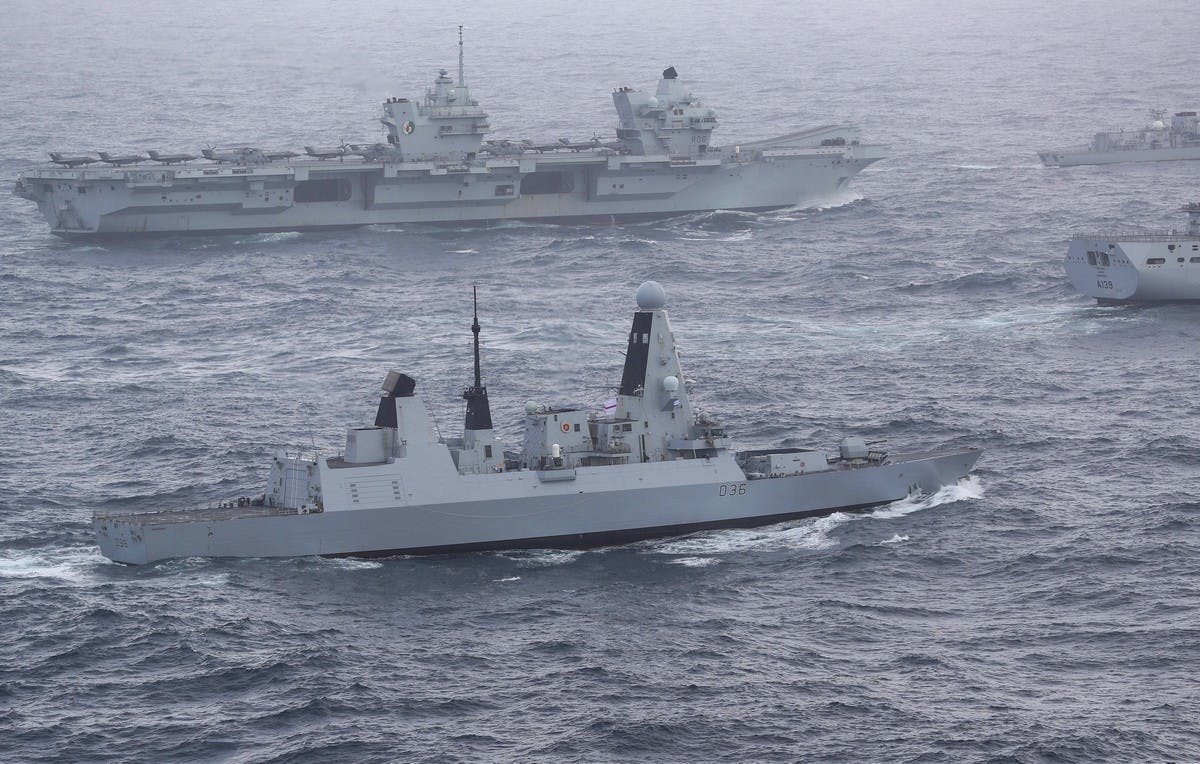
So great is the impact of larger vessels as a deterrent, they’re often used as a geopolitical chess piece. American governments have, since the second world war, moved aircraft carriers around to demonstrate American resolve.
The particular benefits of using carriers in this way are that they operate on the high seas, where permission is not needed from other countries. Indeed, since modern US carriers are large and imposing they “show the flag” to great effect due to their sheer size alone. Equally, it is often argued that had the Royal Navy had two full sized carriers in 1982 it is more than possible that Argentina would not have attempted to take the Falklands in the first place. Larger carriers don’t have to be packed to bursting point with aircraft to achieve their greatest effectiveness, even with fewer aircraft on board, a ship with a large flight deck can rearm and refuel aircraft much more quickly, this is typically why they allow for much higher sortie generation rates than smaller vessels.
The more crowded the flight deck, the slower the turn-around of each aircraft, the lower the sortie generation rate.
Size also offers greater storage capacity, larger vessels do not have to be resupplied as often, impacting both the effectiveness of the carrier and her vulnerability. Because a carrier is more vulnerable when being replenished, the vessel typically withdraws from station for that function. Much of the time lost is the time spent heading away from station and returning. The smaller the carrier, the more time lost and a bigger logistics chain required in support.
A larger ship is likely to survive damage that will sink or disable a smaller one. The smaller the proportion of a ship that gets damaged, the better the chance that the ship can survive the damage and keep on fighting. It takes sheer size to provide enough protection against all the weapons likely to be used against a carrier, from bombs to cruise missiles to torpedoes.
If a complement of aircraft that would typically be found on one large carrier is split among several smaller carriers, then each vessel needs its own escorts unless they operate together. This would require more resources to operate effectively. It might be argued that splitting up a carrier force would make it more difficult for an enemy to deal with all of it at once but the price paid in escorting ships would be high, making it unfeasible for most navies. Indeed, the most significant effect this would have would be requiring more smaller carriers to do the job of one large vessel, further increasing costs. Each of the smaller carriers in the group is less survivable, more wasteful and less effective than a single larger ship.
4. ‘There are no escort ships to protect her’.
It’s fairly obvious that manning and technical issues with the escort fleet have been causing availability problems but there are still 19 escorts in varying states of readiness.
A senior Royal Navy officer recently insisted that the Royal Navy has enough warships to protect HMS Queen Elizabeth. Rear Admiral Burton, former Commander UK maritime forces, said:
“We have enough frigates and destroyers to protect that task group. We will use coalition frigates and destroyers, but we have enough to deliver a sovereign task group.”
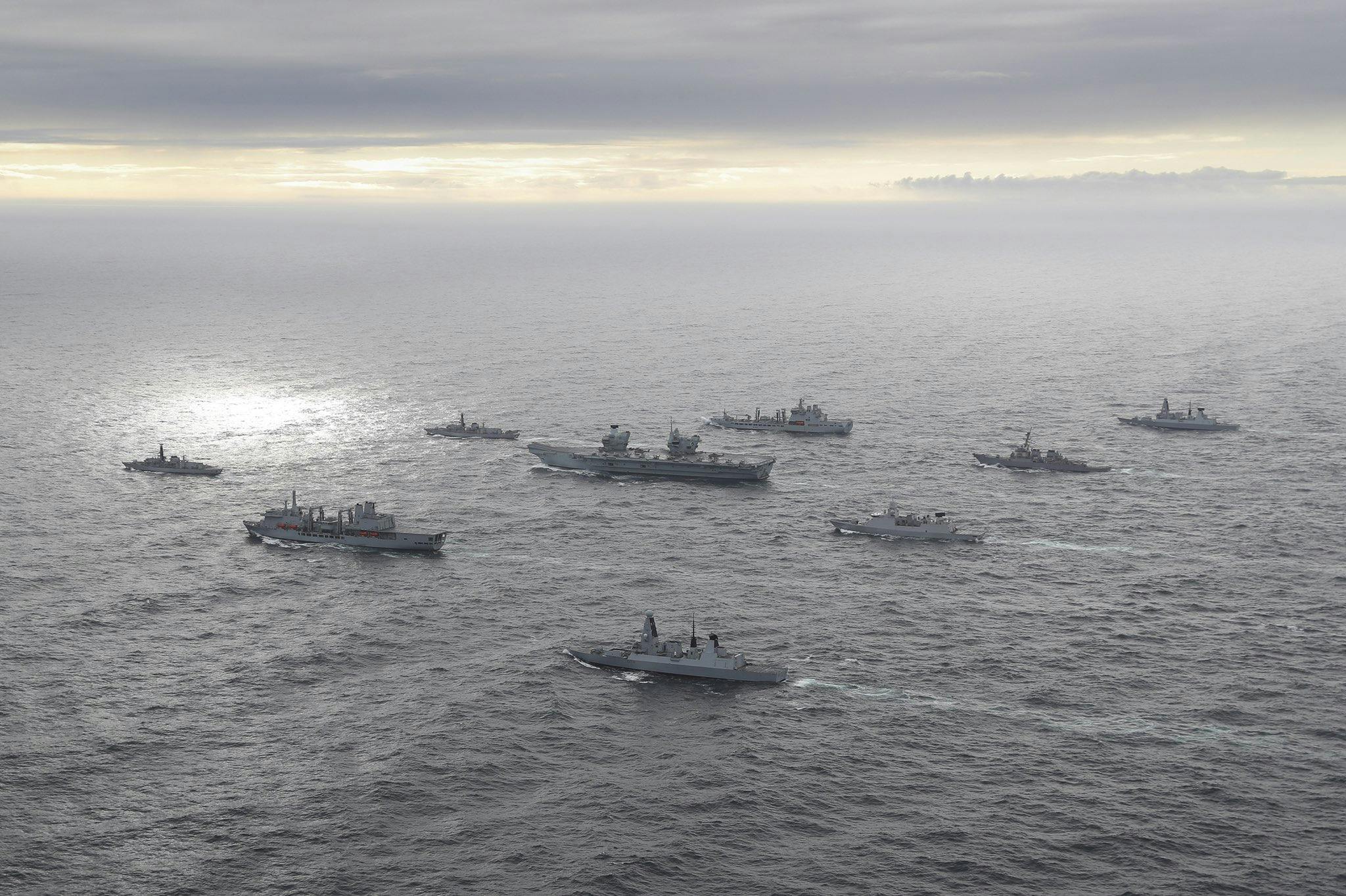
When asked about whether or not the UK has enough escorts to do this without impacting other commitment, Defence Secretary Ben Wallace said:
“The size and the scale of the escort depends on the deployments and the task that the carrier is involved in. If it is a NATO tasking in the north Atlantic, for example, you would expect an international contribution to those types of taskings, in the same way as we sometimes escort the French carrier or American carriers to make up that.
It is definitely our intention, though, that the carrier strike group will be able to be a wholly UK sovereign deployable group. Now, it is probably not necessary to do that every single time we do it, depending on the tasking, but we want to do that and test doing it. Once we have done that, depending on the deployment, of course, we will cut our cloth as required.”
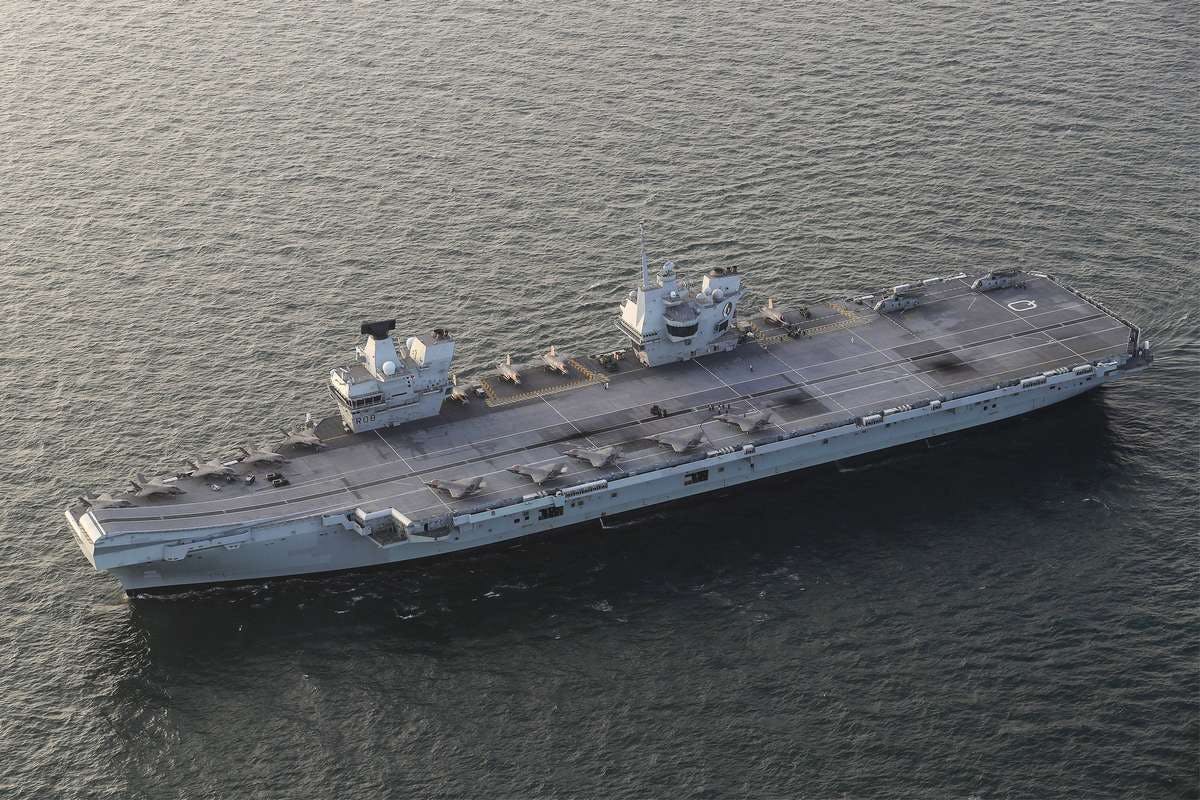
Air Marshal Knighton added:
“The escorts that go with the carrier will depend on the circumstances. The work-up for carrier strike group 21 will be with British ships, because we need to demonstrate and prove that we can do that, but we are already engaged with international partners to understand how we will integrate an Arleigh Burke destroyer from the US or a Dutch destroyer into that package.”
5. ‘One of the ships will be sold/mothballed’.
There are no plans to sell either Queen Elizabeth class ship, zero, nada, zilch. Any suggestion otherwise is pure speculation.

HMS Queen Elizabeth returned to Portsmouth today after a landmark deployment to the United States.
The aircraft carrier spent three months off the east coast, carrying out operational tests with UK F-35 Lightning jets.
She has now returned to her home port – where she was greeted by sister ship HMS Prince of Wales.
Commanding Officer of HMS Queen Elizabeth Commodore Steve Moorhouse said: “Homecomings are always a special occasion, but to be returning to Portsmouth, with HMS Prince of Wales welcoming us home makes this a particularly special occasion.”
Two of her escorts, frigate HMS Northumberland and tanker RFA Tideforce, returned to Devonport today. The ships’ flights also made their way to their respective homes at RNAS Culdrose and Yeovilton.
6. ‘The Americans will be the first to use HMS Queen Elizabeth’.
Recently, the Ministry of Defence confirmed plans for the deployment of American F-35 aircraft alongside British jets aboard HMS Queen Elizabeth (with this recently being successfully trialled in the North Sea as part of Exercise Joint Warrior). However the important thing here is to remember that the US jets will augment the British jets.
American jets will not replace British jets and will not operate from them alone.
Captain Jerry Kyd, former commander of HMS Queen Elizabeth, commented on the initial deployment and the gradual increase in air wing numbers:
“We are constrained by the F-35 buy rate even though that was accelerated in SDSR in 2015, so initial operating capability numbers in 2020 are going to be very modest indeed. We will flesh it out with helicopters, and a lot depends on how many USMC F-35s come on our first deployment in 2021. But by 2023, we are committed to 24 UK jets onboard, and after that it’s too far away to say.”
That being said, there are operational British (and American) jets onboard HMS Queen Elizabeth right now as I’m writing this.
It is understood that the US aircraft will augment British jets on coalition operations, not replace them and not be the first to fly from the new carriers.
7. ‘The F-35 jets that will fly from the carriers are American’.
The F-35 features a significant amount of British developed components. It’s a multinational effort. As the only Level 1 partner, the United Kingdom has garnered tremendous economic benefits from the F-35. The programme is projected to create and support more than 20,000 jobs across the United Kingdom. Hundreds of British software engineers with BAE have played a leading role in creating software for the F-35 aircraft that will be operational with the US Air Force later this year.
The software team at the BAE site in Samlesbury, Lancashire, has worked alongside Lockheed Martin, the prime contractor on the F-35 programme, to deliver the latest update known as ‘Block 3i’. There are more than eight million lines of code required for full operational capability. Block 3i equips the aircraft with 89% of the software code required.
John Brindle, principal engineer for F-35 Lightning II Development, said:
“Beginning with Jaguar, BAE Systems has a long history and world-class expertise in developing software for aircraft systems. We have made a significant contribution to 3i, including producing software for the fuel management system, on-board vehicle systems, structural health management and elements of the navigation and cockpit display system.”
According to Lockheed Martin:
“The fingerprints of British ingenuity can be found on dozens of the aircrafts key components. BAE Systems, GE Aviation, Martin-Baker, SELEX, Cobham, Ultra Electronics, UTC Actuation Systems and Rolls-Royce are just a few of the more than 100 U.K.-based suppliers for the programme.”
8. ‘The ships were only built to benefit Scottish yards and have no strategic purpose’.
There were 3,000 people in Rosyth, with another 8,000 people working at sites around Scotland, England, Wales and Northern Ireland were involved in everything from building segments of the hull to parts of the systems installed on the ships. Then there’s the wider supply chain network, involving hundreds of companies around the UK. In short, the jobs created and the effort going into this new British built icon are unprecedented for a single project in the 21st century.
The origins of the massive and sometimes controversial Queen Elizabeth class carrier programme lie in the 1998 Strategic Defence Review. The review re-evaluated every weapon system (active or in procurement) with the exception of the Eurofighter Typhoon and the Vanguard-class ballistic missile submarines.
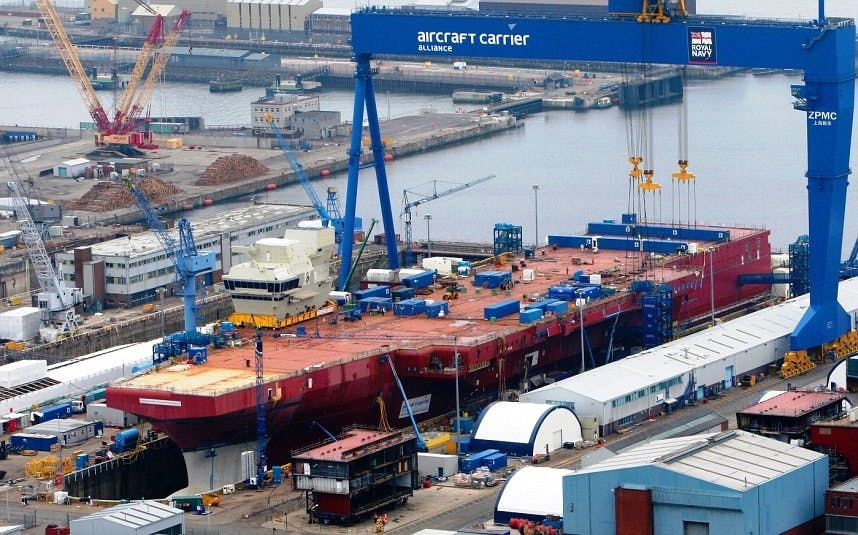
The report identified that aircraft carriers offered the following:
- Ability to operate offensive aircraft abroad when foreign basing may be denied.
- All required space and infrastructure; where foreign bases are available they are not always available early in a conflict and infrastructure is often lacking.
- A coercive and deterrent effect when deployed to a trouble spot.
The report concluded:
“The emphasis is now on increased offensive air power, and an ability to operate the largest possible range of aircraft in the widest possible range of roles. When the current carrier force reaches the end of its planned life, we plan to replace it with two larger vessels.”
In November 2004, while giving evidence to the House of Commons Defence Committee, First Sea Lord Admiral Sir Alan West explained that the sortie rate and interoperability with the United States Navy were factors in deciding on the size of the carriers and the composition of the carriers’ air-wings:
“The reason that we have arrived at what we have arrived at is because to do the initial strike package, that deep strike package, we have done really quite detailed calculations and we have come out with the figure of 36 joint strike fighters, and that is what has driven the size of it, and that is to be able to deliver the weight of effort that you need for these operations that we are planning in the future.”
9. ‘Nuclear power would have been better’.
Cost is single-handedly the most prohibitive reason the Queen Elizabeth class are not nuclear powered. More conservative estimates say a reactor adds 280% to the lifetime costs of a ship. Aircraft carriers typically only carry a month’s worth of aviation fuel, including US and French nuclear vessels, so need to be refuelled monthly anyway. There’s no real operational advantage to having the vessels nuclear powered, especially when weighed against the massive increase in costs.

Tide Class tankers, of which RFA Tidespring is the first, are replacing the RFA’s current, ageing single-hulled tankers.
For more on why nuclear power doesn’t make much sense for the new carriers, I fully recommend ‘The reasons HMS Queen Elizabeth is not nuclear powered‘ by savetheroyalnavy.org.
10. ‘She is named after the current Queen Elizabeth’.
The name HMS Queen Elizabeth is a continuation of an historic Royal Navy name dating back over a century and the vessel herself is not named after the current monarch.

10. ‘She leaks!’.
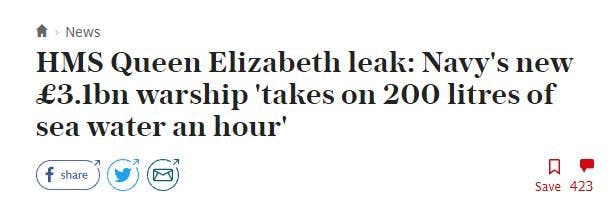 The HMS Queen Elizabeth made headlines last year when a leak was discovered on board. Issues like this occur often on vessels of all types, especially during a phase of their life designed to identify and rectify faults. A minor leak on a ship is not a serious concern, in fact it’s very common.
The HMS Queen Elizabeth made headlines last year when a leak was discovered on board. Issues like this occur often on vessels of all types, especially during a phase of their life designed to identify and rectify faults. A minor leak on a ship is not a serious concern, in fact it’s very common.
This happened during the ships sea trials, a stage of her life designed to find and resolve issues.
While some argue that this is a major issue it should be noted that the Royal Navy themselves seemed confident that it would not impact the schedule of the vessel and they were correct. We spoke to someone serving on board the vessel via e-mail, he told us under the condition of anonymity:
“We’re bemused, nothing more nothing less. This so called issue isn’t a new thing and it’s not what I would call serious. It’s disappointing to see how easily this has been blown out of proportion.”
A Royal Navy spokesman said:
“An issue with a shaft seal has been identified during HMS Queen Elizabeth’s sea trials; this is scheduled for repair while she is alongside at Portsmouth. It does not prevent her from sailing again and her sea trials programme will not be affected.”
The Sun says that HMS Queen Elizabeth has been taking on up to 200 litres of sea water every hour.
“A faulty seal around one of the vast warship’s propeller shafts means 200 litres of sea water pour in every hour.”
A typical bilge pump even on a narrow boat, by the way, can handle over 1000 litres per hour.
Admiral Chris Parry told Sky News the leak was a non-issue:
“Every ship, to tell you the truth, takes on water that’s why you have pumps. What people have to realise is the whole reason for sea trials is that you race and rally the ship, you stress it right to its extremes, and you’re really looking for faults like this to see what happens.
You get this all the time, you’ve got very complicated engineering under the water, it’s operating obviously at sea and every yachtsman will tell you they take in water somewhere, that’s what you’ve got pumps for, that’s why you have dedicated engineers, it really is no big deal I have to tell you.”
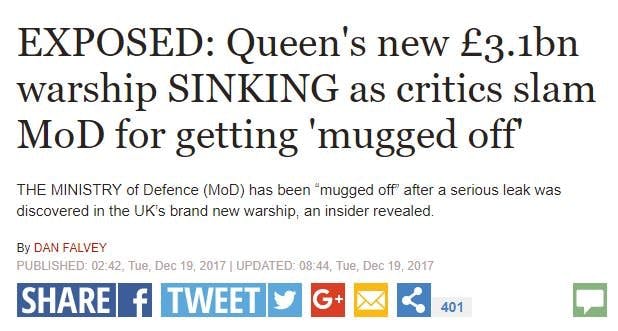
The ThinPinstripedLine response to the story about the ‘leak’ can be found here and summarises today’s events very well.
“The issue affecting QUEEN ELIZABETH seems extremely minor, easily fixable and not remotely in the same league of problems that other ships have had. It is a testament to the quality of British shipbuilding skill, and the strength of the CVF design that she has come through trials with only very minor problems.
The battle for the Royal Navy though is pushing this narrative against a media determined to make a minor technical problem into a major PR disaster for the Navy. In the public mindset the front page news today will help set the narrative for the ships early life, regardless of how utterly untrue it is.
Part of this stems from a lack of understanding on the purpose of sea trials, or that faults will occur, but that they are easily fixable. It also stems from the problem that as papers have scrapped their specialist journalists, the days when deep experts like Desmond Wettern could be relied on to provide deep knowledge and understanding, spotting when an issue was a non-event, or equally when what the RN wanted to make out was a non-event was actually a scoop are long gone.”
The shaft seal issue was identified during trials and seemingly was not deemed serious enough to delay subsequent activities. While obviously this is an issue, it’s not a major issue as the 200 litres an hour will easily be handled by the ships pumps until the issue is resolved, which it will be before she sails. To put it in perspective, that’s around two bath tubs of water.


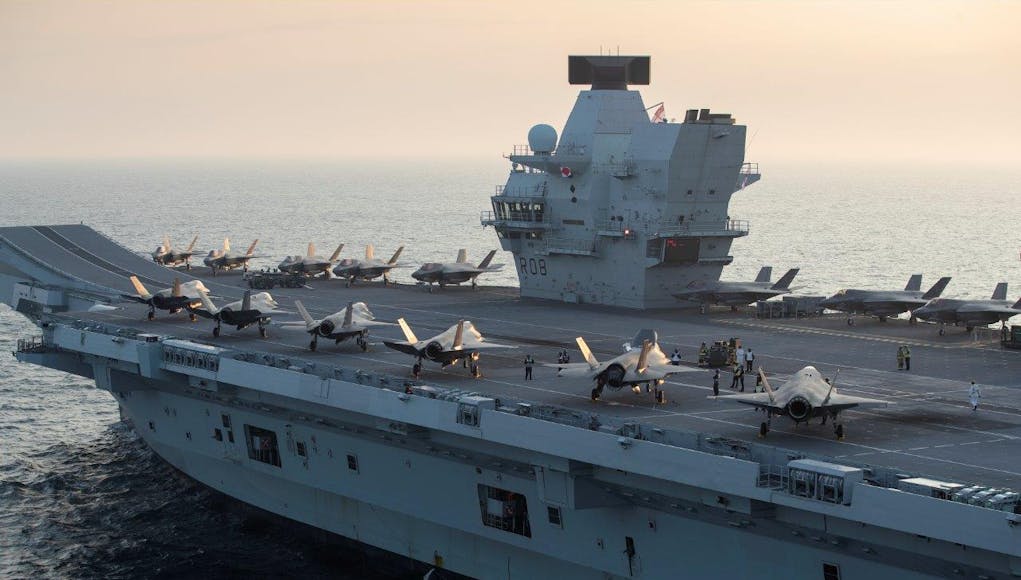

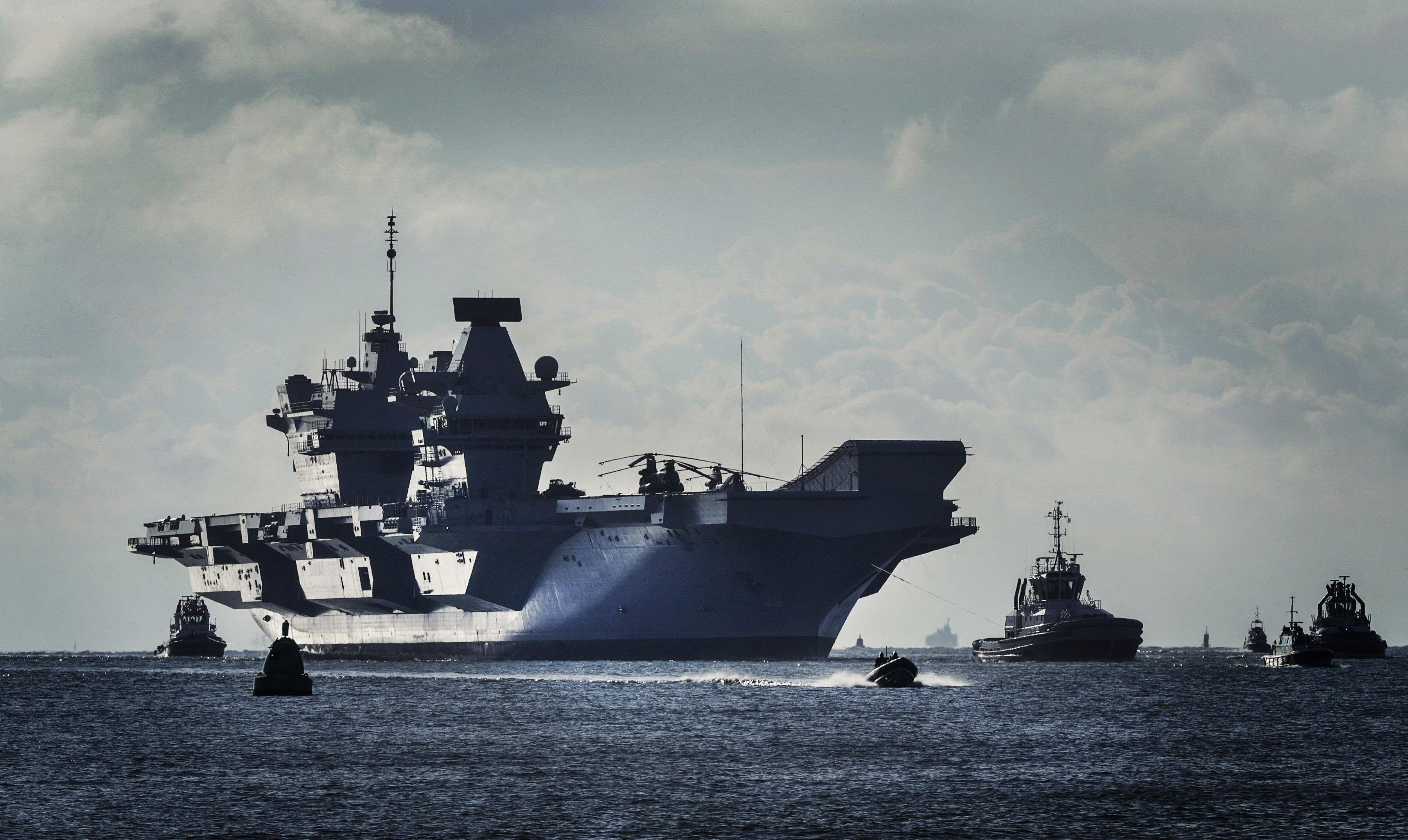
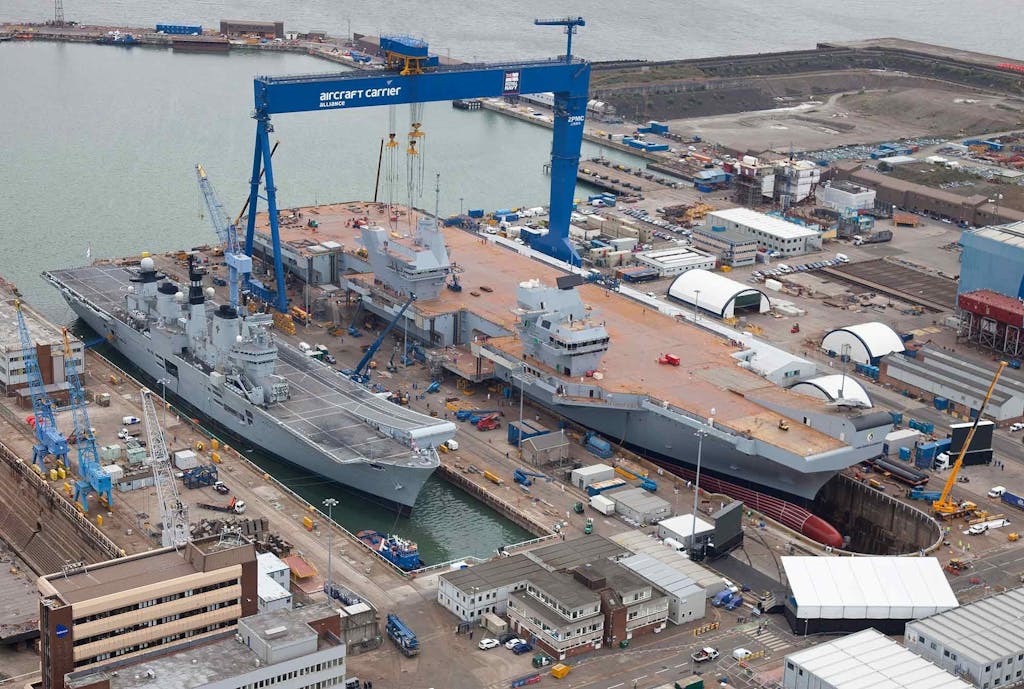
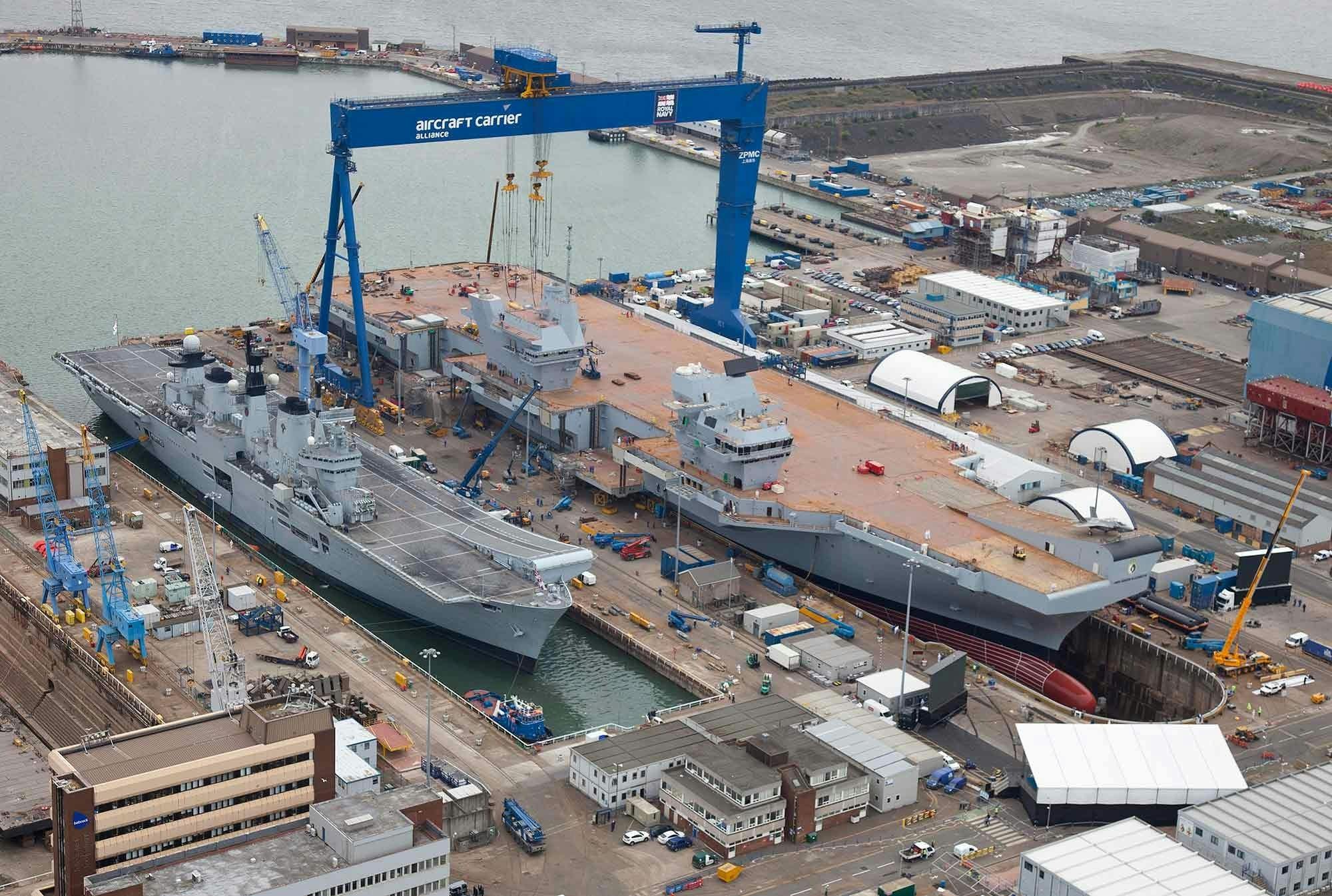
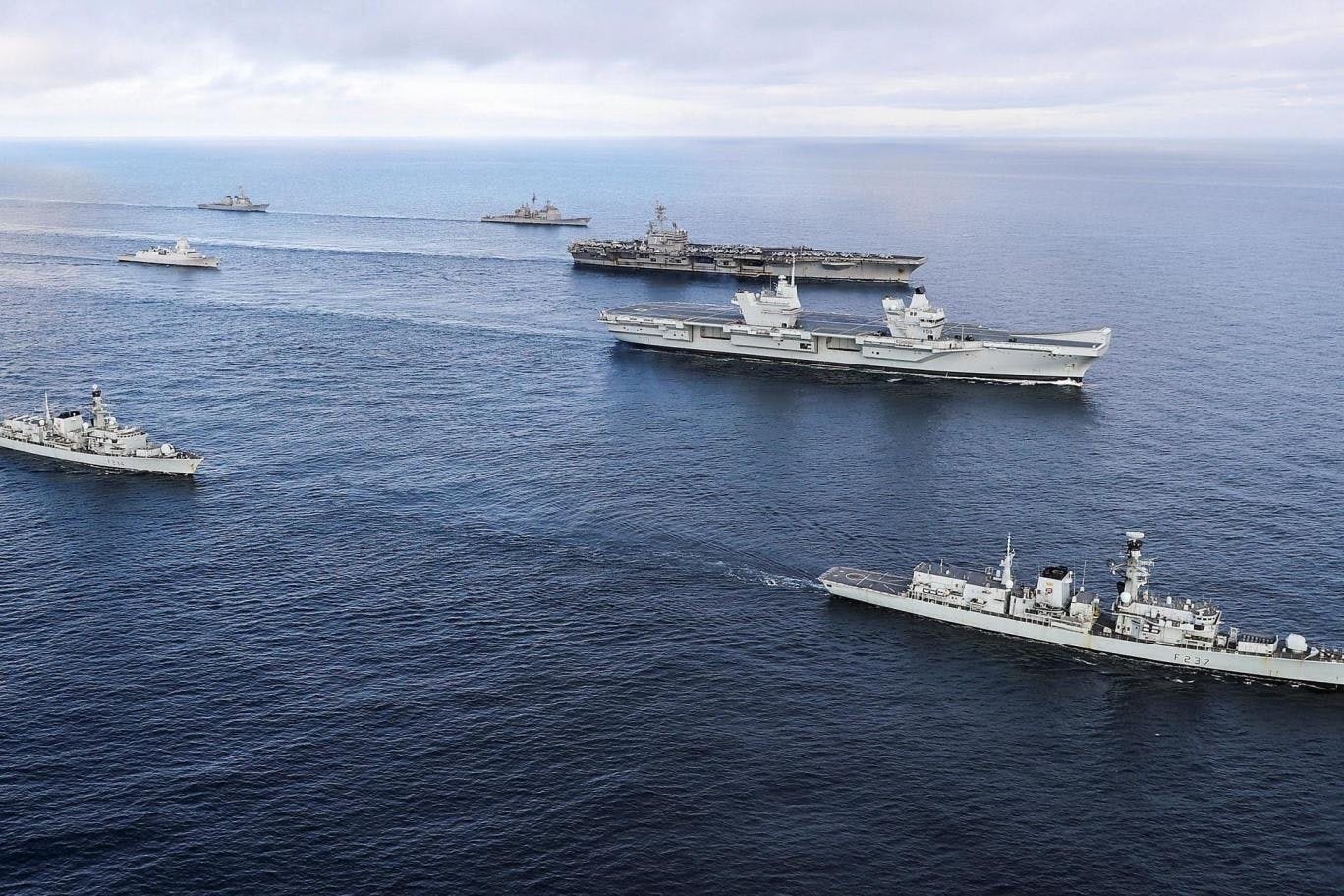
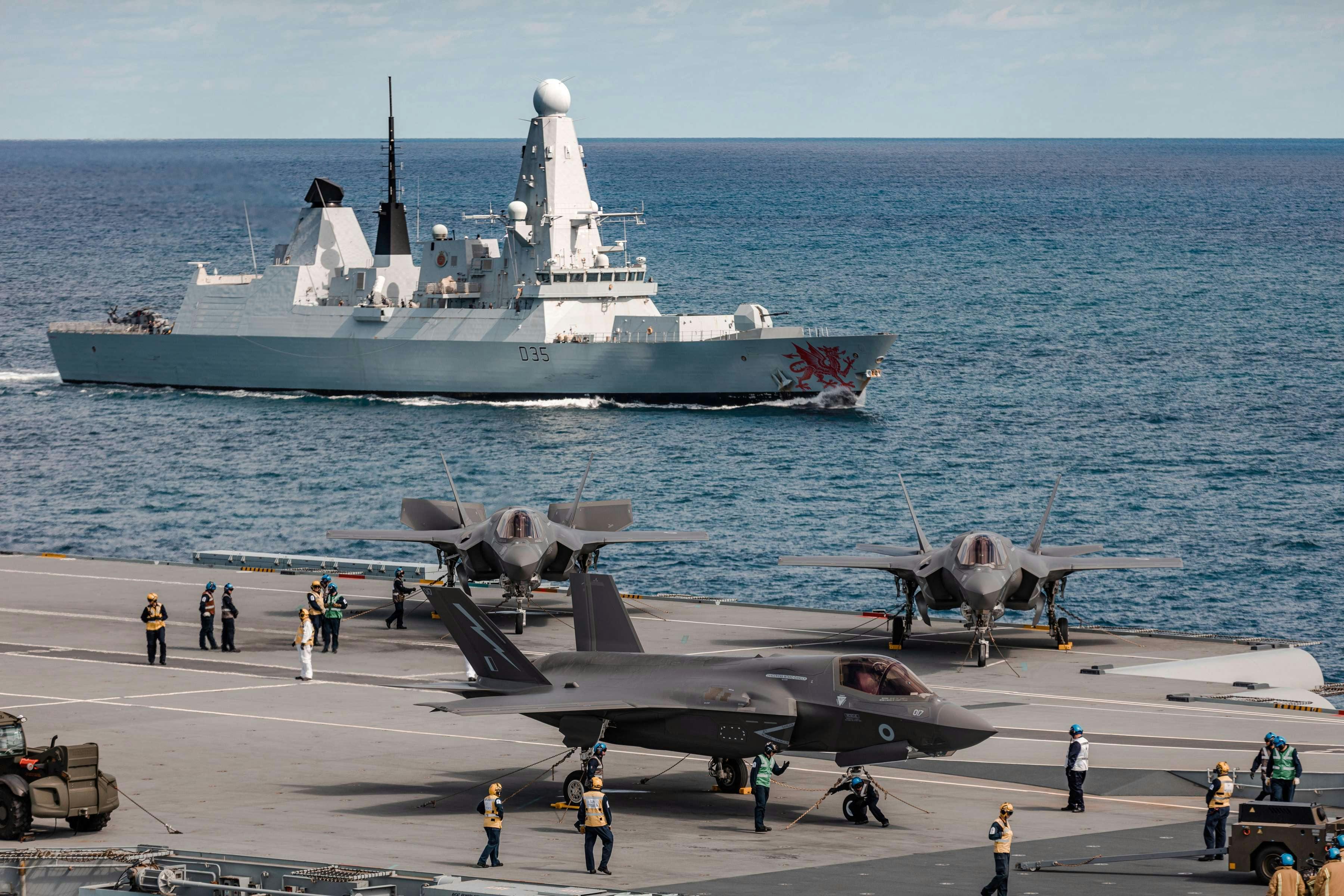
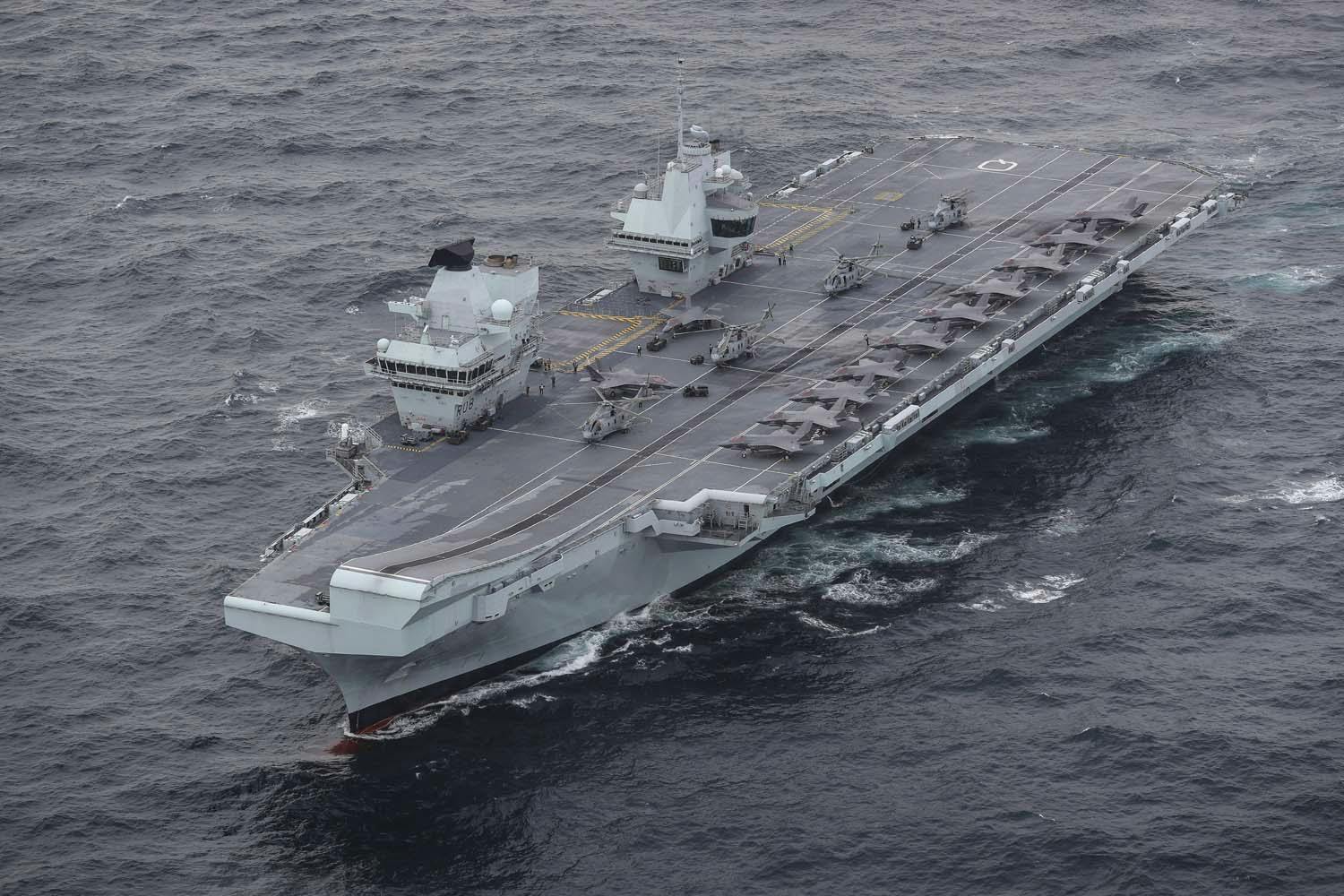











It’s not a myth the F35B buy rate is too slow. There were meant to be additional aircraft delivered this year (a tiny number) but it hasn’t yet happened. On the recent exercise, RAF/FAA only deployed 5 of 15 aircraft, yet this is meant to be a major milestone for preparation for the cruise next year. The MoD are overly reliant on the USMC to make up numbers. What happens in the scenario where the UK gets into conflict without the americans – no matter how unlikely that may seem? There are too few helicopters and question marks about support auxiliaries.
It looks a terrific capability and its great that the RN have this but lets not kid ourselves that there aren’t some fundamental weaknesses which need to be fixed quickly
A carrier without a KETTLE :O haha give over
It’s not a myth
1. That the UK does not have enough F35B. Recent deployment only had 5 UK F35B onboard and 15 USMC F35B
2. Nuclear power may be more expensive, but it requires much less resupply. Diesel for the ship requires a lot if room to store and needs to be done more regularly vs nuclear powered carriers. Saying both types of ships need to resupplied is disingenuous since the rate of resupply is drastically different. Trying to suggest that threre is no difference is just sad.
3. There was a leak, in fact there is another leak with over 1m of water flooding HMS Prince of Wales’s engine room https://mobile.twitter.com/jeromestarkey/status/1317049456613785601
All in all it’s not a disaster but to pretend there is no problem is just ludicrous.
The point is, people are generally ignorant, see a sensationalised headline and blow it out of all proportion to the extent it becomes – Fake News.
The press and media releases naturally focus on the positive. If you were writing your CV you wouldn’t point out and sensationalise those traits about you that were uncomplimentary would you.
The MoD push out facts. The tabloids then spin it to sensationalise the data.
I don’t get where you are coming from, particularly re nuclear power.
The UKDJ is at least accurate and at best righting the detritus pushed by mainstream media and ignorant armchair bloggers.
The whole ‘myth’ around them using XP needs clarifying, as its not exactly a myth, as confirmed by the article.
They are using an OS based on XP core, which means it shares a number of vulnerabilities that XP does, just not all.
Its the same thing as 2 different car designs using the same engine. The doors etc don’t share the same problems, but the engines still do.
Another example is Android, at its core its Linux, and it doesn’t matter if you have an amazon echo or a Samsung phone, they share the same core.
Clearly the core is a smaller subset of the wider XP OS and so easier to protect, but calling it a myth is incorrect.
A myth means it is totaly incorrect, not that it is mainly correct with a few caveats.
It’s the same with the not enough escorts (the quote clearly states it will be a challenge to keep up existing commitments without allies help, which means not enough) and same for other of the myths.
“The planes on board are American”
And?! So is the Chinook and numerous other types.
This country of ours seems to have it in its DNA to put down at every opportunity.
I think this started in earnest with ‘Oh what a lovely war’. You may remember the cynical film from 1969. It was a powerful and destructive pastiche of WW1, some justified some not.
No, I was not born yet. And not seen the film.
It’s so frustrating. And it’s certainly not in my DNA!!
I thought the claim being made when people say “the planes on board are American” is that we don’t have any of our own, and so we would have to rely on the US to deploy aircraft to HMS Queen Elizabeth when she becomes operational.
Lol! Now you mention it, it could indeed mean that Dan….! Duh!
‘No cats and traps’ is often raised.
Where’s the bit about they should have been cat and trap for F-35C and FA-18 compatible.
I’m surprised the information regarding delivery times, quantities of aircraft and operating systems is made public. Is it supposed to be a deterrent or simply my toy is bigger/better than your toy. I am aware that this and other governments leak information like a damaged faucet but the question remains why make things easy for a potential foe? Let their agents earn their money instead.